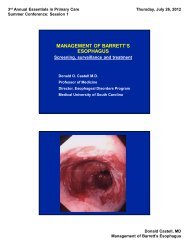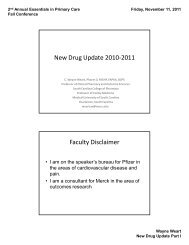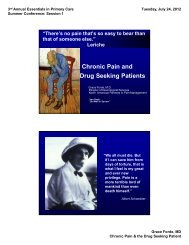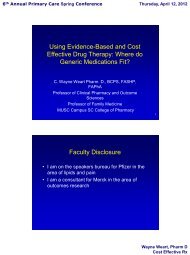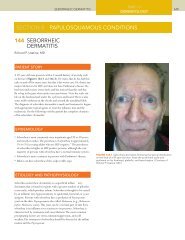163 BASAL CELL CARCINOMA SECTION 12 SKIN CANCER
163 BASAL CELL CARCINOMA SECTION 12 SKIN CANCER
163 BASAL CELL CARCINOMA SECTION 12 SKIN CANCER
You also want an ePaper? Increase the reach of your titles
YUMPU automatically turns print PDFs into web optimized ePapers that Google loves.
MHBD<strong>12</strong>5-<strong>163</strong>[704-711].qxd 8/15/08 11:39 AM Page 707<strong>BASAL</strong> <strong>CELL</strong> <strong>CARCINOMA</strong>PART 13DERMATOLOGY707with 5 mm halo.This can be divided up into two 30 second freezeswith a thaw in between. Some patients might prefer local anestheticif the freezing is too painful. SOR• Curettage and desiccation (six studies, n 42<strong>12</strong>): Recurrence rateranged from 4.3% to 18.1%; cumulative 5-year rate ranged from5.7% to 18.8%. 1 Three cycles of curettage and desiccation can producehigher cure rates than one cycle. 1 SOR• Imiquimod is FDA approved for the treatment of superficial BCCless than 2 cm in diameter. 2 SOR Confi m diagnosis with biopsyand use when surgical methods are contraindicated. 2PATIENT EDUCATIONWhile most of the sun damage has been done, patients should stillpractice skin cancer prevention by sun-protective behaviors such asavoiding peak sun, covering up and using sunscreen.FOLLOW-UPPatients should be seen at least yearly after the diagnosis andtreatment of a BCC.The 3-year risk of BCC recurrence after having asingle BCC is 44%. 3PATIENT RESOURCESThe Skin Cancer Foundation has an excellent web site with photosand patient information—http://www.skincancer.org/basal/index.php.FIGURE <strong>163</strong>-7 Advanced sclerosing BCC on the cheek of a man,causing ectropion (the eyelid is being pulled down by the sclerotic skinchanges). (With permission from Usatine RP, Moy RL, Tobinick EL,Siegel DM. Skin Surgery: A Practical Guide. 1998, St. Louis: Mosby. )PROVIDER RESOURCEBritish Journal of Dermatology (1999;141:415–423) for specifiguidelines for managing BCC—http://www.bad.org.uk/healthcare/guidelines/Basal_Cell_Carcinoma.pdf.FIGURE <strong>163</strong>-8 Basal cell nevus syndrome with multiple nevoid BCCson the face and neck of a young woman. This is a rare autosomal dominantcondition. (Courtesy of the University of Texas Health SciencesCenter, Division of Dermatology.)




